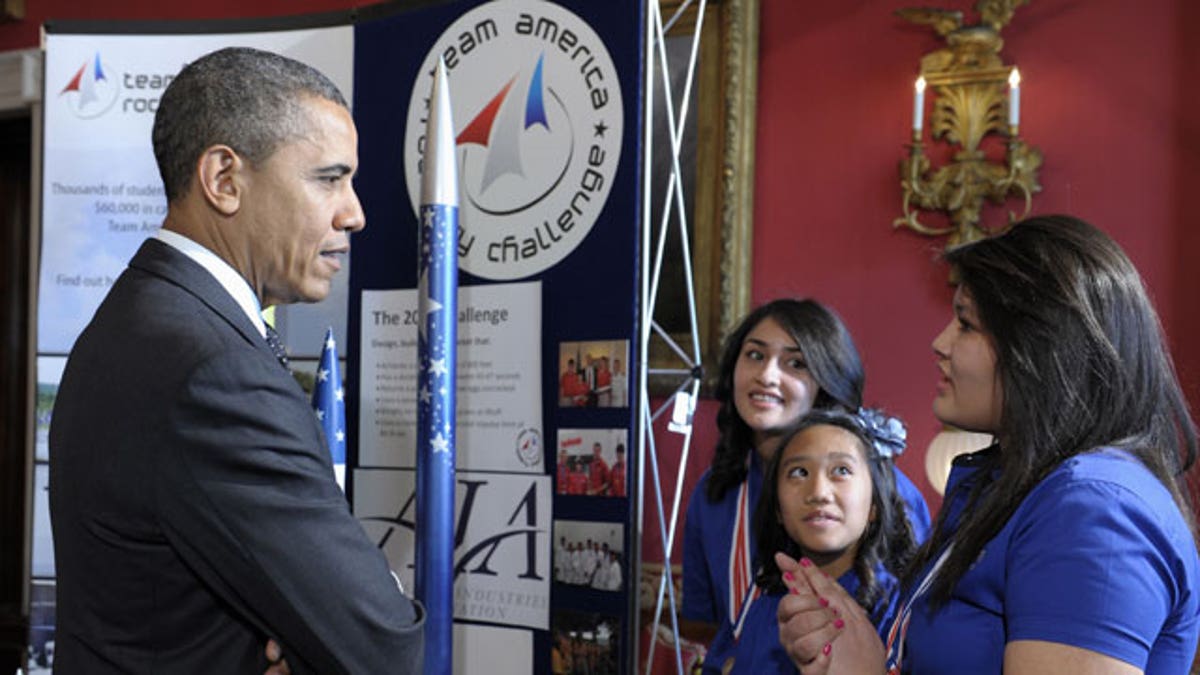
Feb. 7, 2012: President Barack Obama talks with, from left, Janet Nieto, Gwynelle Condino, and Ana Nieto, all from Presidio, Texas, in the State Dining Room of the White House in Washington during the White House Science Fair. (AP)
When NASA introduced Dr. Franklin Chang-Díaz as the nation’s first Latino astronaut, I was a senior in high school, listening to the news on a transistor radio and forever affected by the breakthrough. It was then I knew I wanted to be –and could be– an astronaut.
Years earlier, my family –all of us– often spent seven days a week as migrant workers. After a long day of working the fields, my father would ask us kids how we felt. We were
all exhausted and muddied. “Good,” he would say. “This is your future if you don’t study in school.”
African-Americans, Latinos and American Indians are collectively 26 percent of the working population in the United States, collectively accounting for just nine percent of the workers in science and engineering fields.
When I look back, it was my father’s warning that helped me focus in school, and it was the wonderful news of Dr. Franklin Chang-Diaz that helped me realize how far I could go. The combination of the two led me to become, like Chang-Diaz, a NASA astronaut.
Few would say my path was easy, but there’s a challenge for us today in how we inspire more students to explore fields in science, technology, engineering and mathematics (STEM). Just four percent of the bachelor’s degrees earned in 2008 in the U.S. were in engineering. In Asia, that number was 19 percent, and in China it was 31 percent.
It doesn’t take a rocket scientist to realize we are trailing the rest of world when it comes to developing STEM talent, a true barrier for any nation wanting to remain globally competitive. The problem is exacerbated by recent cuts in education, a side effect of the recent recession. Twenty-six states are providing less per-student funding during the current school year, and education spending in 35 states is below 2008 levels, according to the Center on Budget and Policy Priorities.
While the cuts this year are mostly modest, they are in addition to much steeper cuts that occurred from the past few years. California per-student spending has decreased by more than 17 percent since 2008, with just five states –Arizona, Alabama, Oklahoma, Idaho and South Carolina– curtailing spending by more.
Budget realities and our inability to produce enough students trained in science, technology and engineering (STEM) fields have created a perfect storm that threatens our STEM education pipeline and, with it, the nation’s ability to be globally competitive. If there was a handy solution, virtually every state would have it in place by now.
I am encouraged knowing that leaders on both sides of the aisle recognize the importance of investing in the education of our nation’s students, and perhaps it is fitting that one of the most promising solutions to bolstering the nation’s STEM education pipeline comes from a bipartisan group of U.S. Senators.
Senators Orrin Hatch (R-UT), Amy Klobuchar (D-MN), Marco Rubio (R-FL) and Chris Coons (D-DE) introduced the Immigration Innovation Act of 2013, a high tech immigration reform bill that makes needed reforms in the skilled labor sector.The bill, dubbed I-Squared, uses fees from companies who pay for H-1B visas and green cards to fill vacant high-skill jobs to establish a national fund to help states fund improvements to STEM education.
With tax dollars shrinking and many states struggling to restore the cuts to education, this funding stream is crucial especially in communities where STEM education is lagging. STEM has more than a funding problem – it also has a demographic problem. African-Americans, Latinos and American Indians are collectively 26 percent of the working population in the United States, collectively accounting for just nine percent of the workers in science and engineering fields and just 11 percent of graduates with science or engineering degrees.
The National Center for Technological Literacy sums up the challenge: “Without increasing the numbers of minorities in engineering and technology as the percentage of white males in the workforce decreases, the number of engineers will also decrease.” Our task is clear. We have to do a lot more to ensure more students are exposed to STEM instruction. It’s one of the reasons educators and education officials should be paying attention to the I-Squared Act.
The STEM fund will be used to recruit and train more teachers in STEM fields, broaden access to computer science classes for high-school and help students who start college in STEM fields earn their degrees. Our long-term economic prospects will depend on how effective we are at producing the workers who will be the innovators of tomorrow. I am thrilled that there’s a promising path to meet that challenge. We can’t miss this opportunity. Too many futures, including America’s, are riding on it.
